We Stored and Ripened Bunches and Bunches of Bananas—Here Are the Best Methods
Bananas ripen as a group quickly. Here are the best ways to both slow and speed ripening, tested and explained.
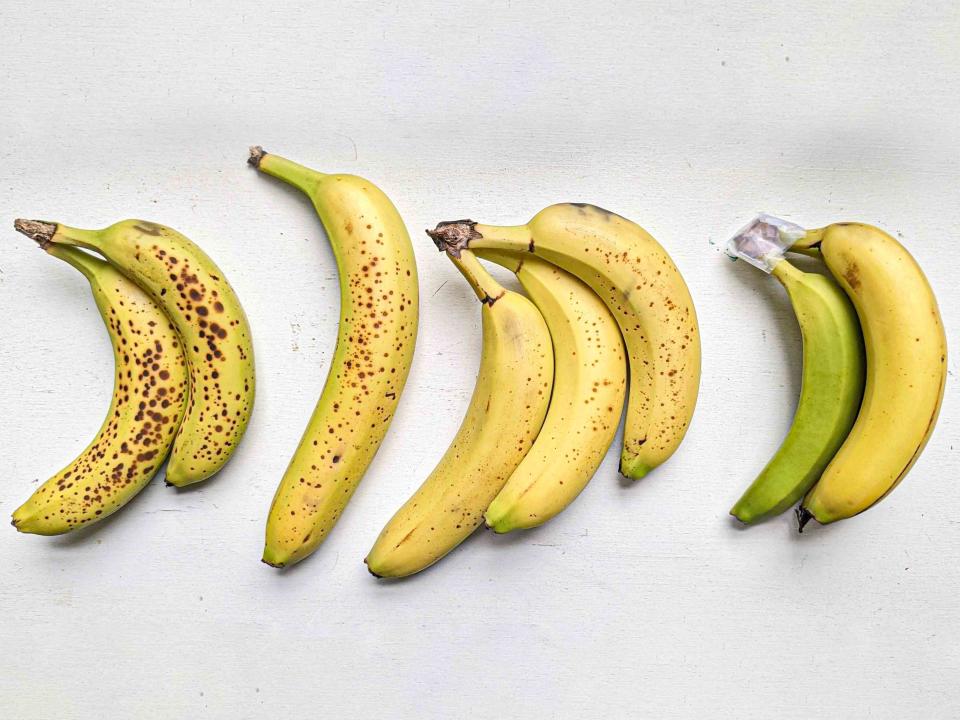
Serious Eats / Daniel Gritzer
A bunch of bananas can look, at first, like the ultimate convenience, a graceful cluster of plump arcs nestled together by nature's workshop for efficient transport and storage. And then they all turn yellow then brown and before you know you're planning your next batch of banana bread. The sad fact is, bananas don't care one bit whether they fit into your personal snacking schedule—once you've been tempted by their sugary sweetness and grabbed the bunch their evolutionary purpose of seed dispersal has been achieved. If they all ripen at once, so be it.
I'm of course giving bananas agency they don't have. They don't "care" about anything and, with the cultivars we buy at the store today, there's not a seed inside almost any banana that can grow into a future banana plant. Regardless, we're all constantly dealing with the frustrating experience of having a whole lot of bananas that are all either not ready to eat, very suddenly all ready to eat, and then very quickly too ripe to eat (but still great for baking). No wonder so many people are in search of tips on banana ripening, both how to speed the process up and how to slow it down. Gaining just a little bit of control over the progression from green to yellow to spotted to full-blown brown can mean the difference between being able to eat bananas when and how we want and not.
There is a lot of information out there about banana ripening strategies, but practical testing is always a plus (and not always a given on some websites). So for the past couple weeks I've been buying and storing bananas all sorts of ways in search of the methods that seem most effective for influencing banana ripeness.
I ran my storage tests twice. Each time, I shopped for the bananas from the same store, choosing bunches that were the same brand and from the same origin, and with the same level of ripeness as judged by visual inspection. The first time, I stored my bananas at home for three days before inspecting, and the second time in my office for two and a half days; the office is air-conditioned all the time, and thus is colder than my home by about 5 to 10°F (3-6°C). I inspected all samples visually and tasted them as well.
How Bananas Ripen
Bananas hold the honorable distinction of growing on the world's largest flowering plant—despite appearances, they are not trees. The fruits themselves, which grow in the clusters we all recognize from stores, are a climacteric fruit, which means that once picked they continue to ripen during a maturation phase marked by high levels of respiration and the production of the ripening gas ethylene. As bananas ripen, enzymes in the banana's flesh break down complex starches into sweet sugars, raising sugar levels from close to 2% in the unripe stage to 20% when ripe. At the same time, the pectin that holds cell walls together is weakened, leading to a pleasant softening in texture.
This ripening phase can happen rapidly and dramatically with bananas, so a specialized process is required to successfully ship them from tropical growing regions to the rest of the world without them turning to a puddle of rotting ooze by the time they arrive. To do this, bananas are harvested when the fruit is still in a very unripe, green state and then kept in temperature-controlled storage at around 55°F (13°C), which fully halts the ripening process.
Once they've arrived at their destination, they are brought to processing facilities where they are exposed to ethylene gas and slightly warmer temperatures, jump starting maturation again. From there, bananas go to the store, and then your home, where they quickly shift through varying degrees of ripeness until they're no longer good for much other than banana bread.
It's important to note that while the color of bananas shifts from green to yellow to brown as they ripen, color is not a perfect signal of ripeness. In my own testing, I had some bananas that retained a green tint even as the fruit inside matured to a good eating level, which made me wonder why that had happened. I found an answer in this article from the American Society of Plant Biologists, which describes a phenomenon known as "green ripening." In effect, a banana can remain green even as it ripens if the ambient temperature is above about 75°F (24°C). As it turns out, all my bananas that remained greenish even when ripe were at or above that temperature where I was keeping them in my home.
Clearly, the key factors at play with banana ripeness are: temperature and ethylene production, plus any other ways to influence the enzymatic activity that breaks down starches into sugars. I set out to test common methods of speeding and slowing ripening by manipulating things like temperature and ethylene concentration to see how dramatically that could affect the timing it took for the bananas to ripen.
TLDR: Your Best Options for Controlling Banana Ripening
If you want to slow down the rate at which your bananas ripen, the most effective steps are to move them to a cooler area, preferably around or just below 65°F (18°C), and tape the stem end well with Scotch tape (or another similar tape). Separating your bananas into individuals and keeping them apart may also help slightly.
If you want to speed up the rate at which bananas ripen, move them to a warmer area, preferably more than 75°F (24°C). In my tests I found no faster ripening when in a paper bag with or without another ethylene-emitting fruit (such as an apple), but there's no harm in keeping bananas clustered with each other and ethylene-emitting fruit just in case it does provide a boost. You can always use real heat, whether a low oven or microwave, or the enzymatic-ripening effect of egg yolks, to sweeten and soften bananas for baking, though these will generally not be good for eating out of hand.
One unexpected result of my testing: Storing the bananas in a paper bag did seem to encourage more even ripening and resulted in fruit that were more palatable after a few days than bananas that were left out in the open. It might be a good idea to transfer your fruit to a paper bag just as an overall quality-preserving measure even though it may not speed things up.
Test Results: Methods for Speeding Banana Ripening
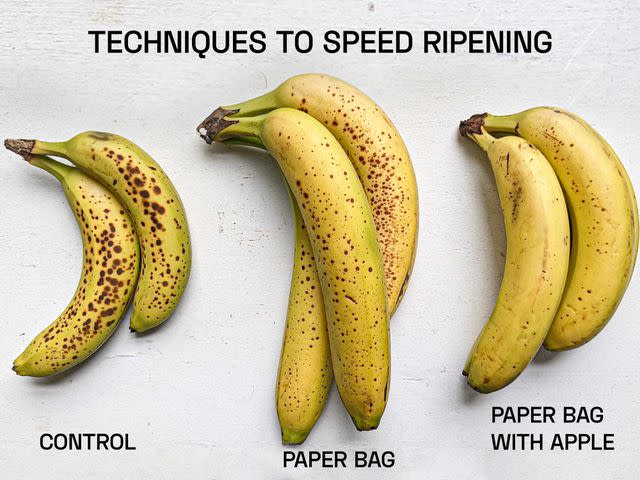
Serious Eats / Daniel Gritzer
The first storage tests I wanted to do involved methods of speeding ripening, either to try to get bananas from a green and immature stage to one where they'd be enjoyable to eat as a fruit or in a fruit salad (meaning, sweet and tender but still firm enough to hold their shape) or ripened further so that they'd be appropriate for baking, banana whip, and other such recipes.
To run these tests, I had one bunch of bananas that acted as a control, and then the rest in their respective storage scenarios. All the bananas started out mostly green with just a trace of yellow and the photos you see here are the results after three days of storage. The ambient temperature for all of the bananas in these tests hovered around 75°F (24°C) (as noted above, this was warm enough to cause "green ripening," in which the bananas ripened while maintaining traces of green chlorophyll in their peels).
Paper Bag
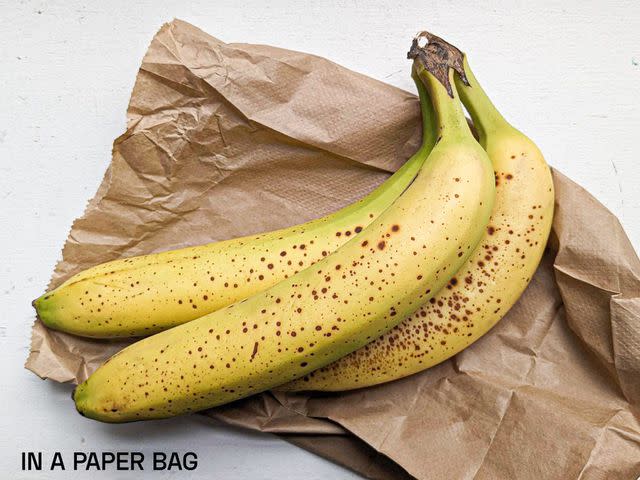
Serious Eats / Daniel Gritzer
Enclosing bananas in a paper bag is one of the most common tips for speeding up ripening. The logic is that the paper bag is permeable, allowing oxygen to enter it and thus continue to feed respiration, while also ensuring humidity doesn't build up inside the bag. At the same time, the bag is meant to trap ethylene produced by the fruit, speeding ripening.
In my tests, I saw little indication even after three days enclosed in a paper bag that the bananas ripened any faster than the control bunch. In my home samples, I think I was able to perceive a slight superiority in texture and evenness of ripening with the bagged samples, but the differences were subtle enough that I wouldn't make too much out of this observation. At my office, the paper bag samples fared much better than the control, ripening more evenly and maintaining a good eating quality. Perhaps this was because the ethylene cloud around the bagged bananas was contained and thus more even, or maybe temperature was kept more moderate and even in the bag, or perhaps more ideal humidity levels were maintained.
In any event, my results weren't what I expected based on the idea that trapping the bananas' ethylene would speed ripening.
Storing Near Ethylene-Releasing Fruit
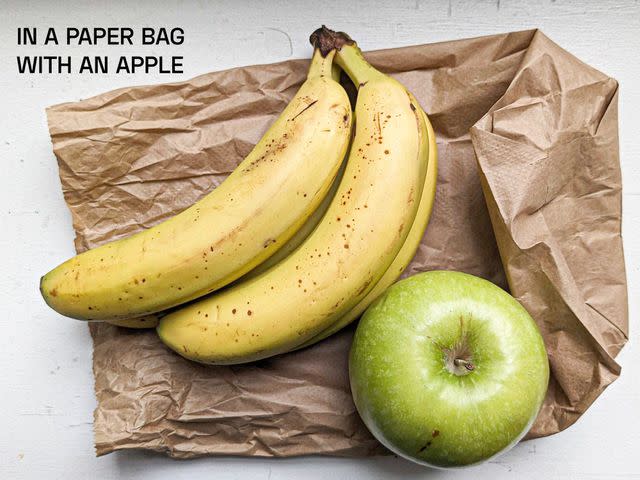
Serious Eats / Daniel Gritzer
Many people recommend storing bananas with or near other ethylene-producing fruit, such as apples, to further speed the ripening process. To try this, I stored a bunch of bananas with an apple in a paper bag. Strangely, at home, these bananas showed slightly less brown spotting than the bananas in a paper bag without an apple and quite a bit less browning than the control group. In my office, the control group was no longer pleasant to eat, having turned mushy and brown in spots; while the two paper bag samples (one with an apple, the other not) were still in very good shape.
In no instances did I find that adding an ethylene-producing fruit speeded ripening, though I can't say that this technique never works—perhaps it does in some instances, depending on the exact positioning of the fruit, the relative amounts of them, and where in their ethylene-emitting phases they are.
Oven "Ripening"
The ripening of bananas is tied to ambient temperature, with bananas held in cooler areas ripening more slowly than those in warmer ones. The next logical step: Speed it up even further by baking the peel-on bananas in a low oven (around 250°F/120°C is a commonly given number).
In my tests, the bananas were warmed through and slightly softened after ten minutes in the oven, with a slightly more pronounced aroma, though there were hints of a perfumy funk. One could eat this banana out-of-hand, but it's not as good as a properly ripened banana and does not taste noticeably sweeter than before baking. After a full hour the banana peels had turned a deep, dark, totally consistent brown color; inside they were watery and very clearly cooked, while ever so slightly more sweet in a sickly-sour way. In a pinch you could use this method for bananas that will be pureed or mixed into a batter and then cooked further, such as for banana bread, but it is not an acceptable option for bananas that will be eaten raw and will not significantly alter the sweetness of the bananas.
Microwaving
The microwave is just another tool for heating bananas. I put a whole, peel-on banana in a microwave and cooked it for 30 seconds at high heat, at which point my microwave had made it warm to the touch. I let it go another 30 seconds and noted some soft popping sounds in the microwave. The banana was hot at that point, with dark brown blemishes spreading across the yellow-green peel. Inside the banana was very warm, with a flavor that managed to taste both underripe and ripe at the same time, but not much sweeter at all. It was quite similar to the 10-minute oven banana—edible but not great.
Egg Yolk–Ripening
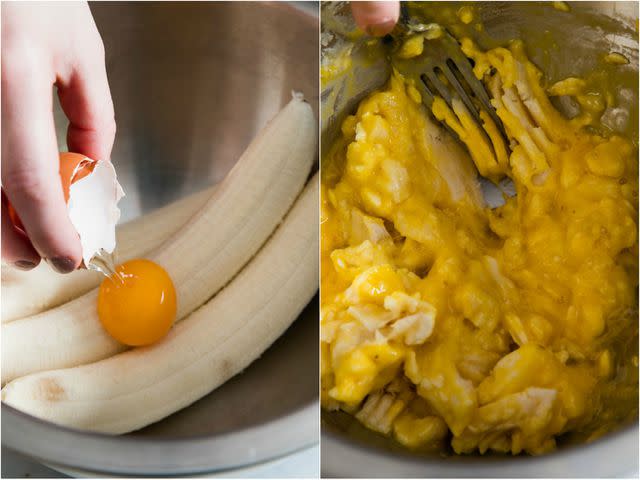
Serious Eats / Vicky Wasik
Stella Parks has written about this clever speed-ripening method before, but it's important to note that because it requires mixing the bananas with raw egg, it only works in situations where you are going to cook the bananas further, and in which the egg will be a welcome addition (such as in a banana bread batter).
The underlying idea is that the egg yolk contains amylase, an enzyme that breaks down the starch in bananas into simple sugars, so by mixing mashed bananas with the yolk and letting it sit for at least 30 minutes, a good deal of starch-to-sugar conversion can take place, much faster than what happens on a banana's natural timescale.
Test Results: Methods for Slowing Banana Ripening
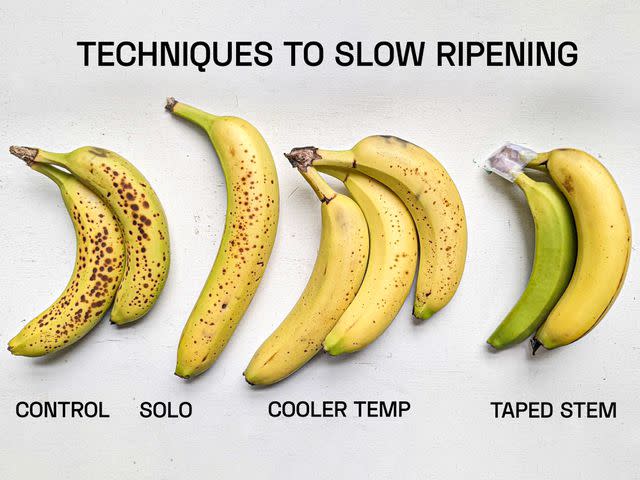
Serious Eats / Daniel Gritzer
Now let's look at the inverted scenario: What to do if you're worried your bananas are going to ripen faster than you can eat them. How can you slow the process down? The methods I tested here showed much better and more consistent results than the ripening-speeding tests, and I was able to repeat my results in both rounds of testing at home and in my office.
Taping the Stem End
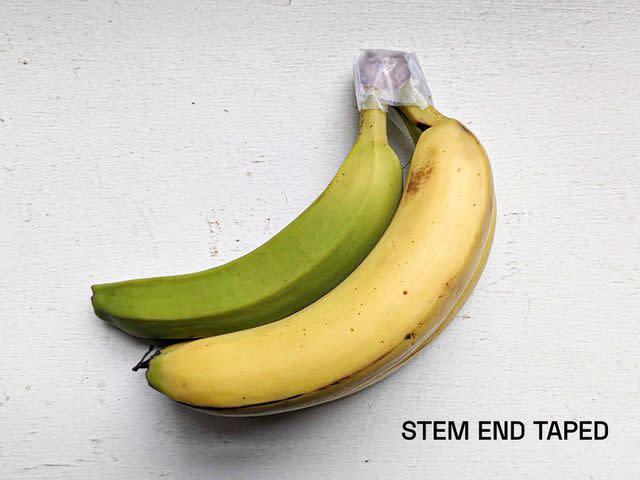
Serious Eats / Daniel Gritzer
In recent years, I've noticed some banana bunches at the market sold with tape around their stem end. The explanation often given is that it's the stem that releases the most ethylene, so sealing it with tape reduces ethylene in the air around the bananas, slowing ripening. I have failed to find any scholarly research to back this explanation up, and I'm quite skeptical of it. I've seen others say it's the stem end that absorbs the most ethylene, and once again I can't find anything to support that claim. (I wonder if taping the stem might have more to do with slowing moisture loss, which is another thing that happens as a banana ripens; could trapping moisture, as one can with a tomato by storing it stem-side down keep a banana from transitioning into further ripeness quickly?)
In my tests at home and in the office, though, I saw quite clearly that taping the stem thoroughly with Scotch tape slowed ripening to a remarkable degree. Even after two to three days, my taped bananas were more green than yellow (in the above photo you do see one banana in the bunch is very green and other other evenly yellow; I believe the green one was for whatever reason quite a bit less mature than its siblings in the bunch and the taping fully halted its ability to progress). I also saw little to no brown spotting on any taped varieties.
I've come across other sources that have had less success with this method, including an experiment done in this YouTube video, but my results suggest that wrapping can indeed work.
Separating the Bunch
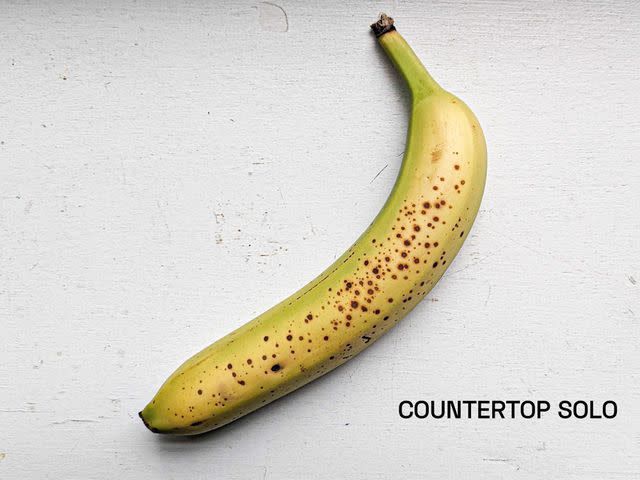
Serious Eats / Daniel Gritzer
Going back to that basic idea that reducing ethylene concentrations can slow ripening, some suggest that separating the bunch so that the bananas aren't awash in each others' ethylene can slow ripening. My tests slightly support this, with my solo bananas seeming to ripen at a slightly slower rate than those in bunches. Perhaps the power move is to split up the bunch and tape each one individually.
Cooler Temperature Storage
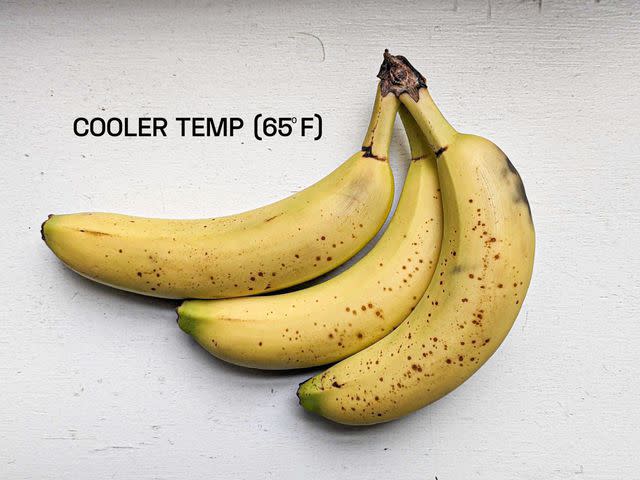
Serious Eats / Daniel Gritzer
If you have the ability to find a cooler spot for your bananas, you will be able to slow their ripening. I kept a test bunch by an open window that averaged around 65°F (18°C), about 10°F cooler than the 75°F (24°C) zone of my other bananas, and the cooler ones ripened more slowly. My office is also cooler than my home, and all my samples there ripened much slower than their counterparts at home after the same number of days.
But then we can ask, can we go cooler? Sure we can!
You can store ripe bananas in the fridge, though my experience is that the cold of the fridge does not lead to bananas that are good to eat raw as a snack. Still, it's an option for preventing bananas from liquifying if you just need a few days before you're able to whip up that banana bread you were intending to make.
And of course the true cold of the freezer is an option as well for any very ripe bananas you want to hold for longer. Just peel and freeze your fully ripe bananas in a zipper-lock freezer bag until you've collected enough to make some banana whip or bread or whatever else might want to use them for.
Low-Oxygen Storage
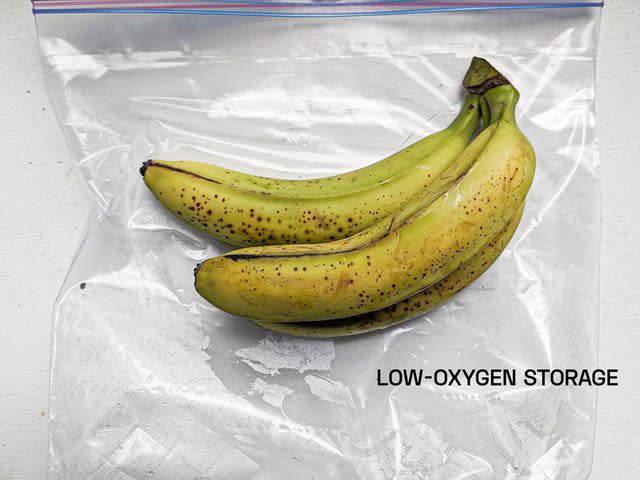
Serious Eats / Daniel Gritzer
I'm not even sure why I tried this one because there's no practical way to do it...but, I was curious. Since respiration drives the ripening process, I wanted to know what would happen if I stored bananas in a low-oxygen environment. So I created a bunch of carbon dioxide with the basic reaction of baking soda with white vinegar and trapped it in a zipper lock with bananas.
Humidity quickly built up inside the bag, but I didn't open it because the whole point was to keep the oxygen out as much as possible, not let it back in. The bananas remained green, but once I opened the bag three days later to taste them, their insides were murky and swampy. Some kind of maturation had happened, but not in a good way.
Is it possible to manipulate the mixture of gases for banana storage successfully? Sure there is—fruit companies do that kind of thing all the time to get their product from farm to market over great distances and times, but it requires a much more sophisticated setup that can maintain specific percentages of specific gases while also controlling humidity levels. Just shoving bananas in a plastic bag and letting them suffocate while sweating ain't the move.
The Bottom Line
To slow down the rate at which your bananas ripen, move them to a cooler area in your home, preferably around or just below 65°F (18°C), and tape the stem end well. Separating your bananas into individuals and keeping them apart may also help a bit. If you want to speed up the rate at which your bananas ripen, move them to a warmer area, preferably more than 75°F (24°C); a paper bag (with or without other fruit) may help maintain overall quality during ripening, but its ability to speed ripening is not at all a guarantee.
Read the original article on Serious Eats.

